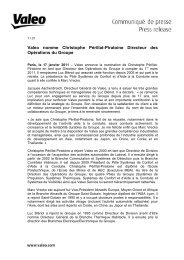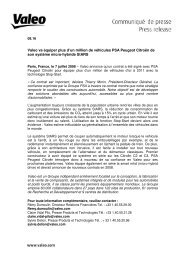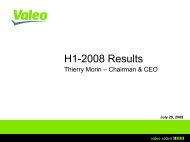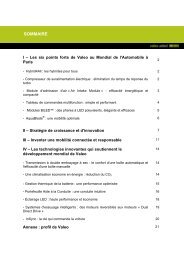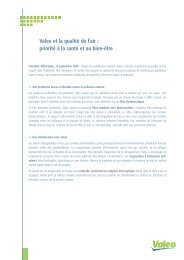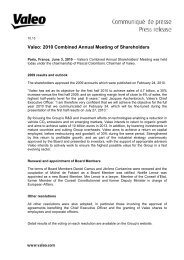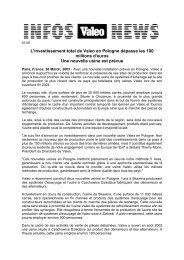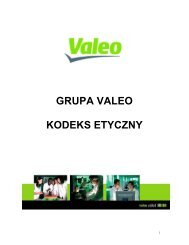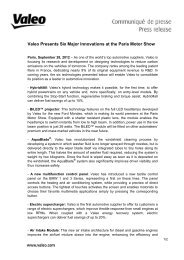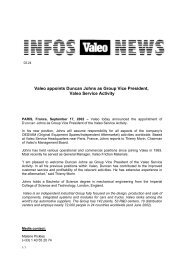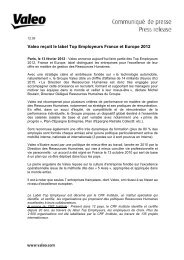2007 Reference document (PDF) - Valeo
2007 Reference document (PDF) - Valeo
2007 Reference document (PDF) - Valeo
Create successful ePaper yourself
Turn your PDF publications into a flip-book with our unique Google optimized e-Paper software.
2.6. Reducing all types of pollution<br />
Minimizing all forms of pollution is another of the Group’s ongoing<br />
environmental objectives, which involve ensuring that industrial<br />
activities are properly integrated into their environment. This concerns<br />
both the performance of products developed by the Group and<br />
the processes implemented to create such products.<br />
The Group has developed the StARS starter-alternator that allows an<br />
engine to be stopped and restarted instantly and silently, resulting<br />
in a notable reduction in noise pollution in urban areas.<br />
Operations at <strong>Valeo</strong> sites are not particularly noisy, and <strong>Valeo</strong> is<br />
careful to locate new sites sufficiently far from residential areas.<br />
In accordance with the recommendations of the <strong>Valeo</strong> Factory Design<br />
guide, the visual impact of sites is taken into account at the time<br />
of their construction, and a large section of each site is given over<br />
to green spaces.<br />
As odor pollution, usually caused by the emission of Volatile Organic<br />
Compounds (VOC), can be particularly unpleasant for local residents,<br />
Management Report<br />
Environmental management and performance<br />
a number of at-source measures have been taken to reduce VOCs.<br />
For example, solvent-based paints have been replaced by waterbased<br />
alternatives, and trichloroethylene has been phased out of the<br />
manufacturing process for clutch facings. The <strong>Valeo</strong> sites concerned<br />
are equipped with systems for treating these compounds in order to<br />
keep odor pollution below the perception threshold. Such systems<br />
include biofiltration, absorption, condensation and incineration, with<br />
incineration being the most frequently used.<br />
<strong>Valeo</strong> is also highly aware of the need to protect the health of local<br />
residents near its sites. In 2005, it compiled a directive on legionella<br />
bacteria. This directive is based on French law, which is one of the<br />
strictest in this domain, and is available at all <strong>Valeo</strong> sites worldwide.<br />
Under this directive, the sites must:<br />
■<br />
■<br />
■<br />
< Contents ><br />
replace wet cooling towers with dry towers wherever possible;<br />
implement preventive treatment systems to avoid the proliferation<br />
of legionella bacteria;<br />
carry out frequent controls to ensure the effectiveness of<br />
treatments in place.<br />
<strong>2007</strong> <strong>Reference</strong> <strong>document</strong> - VALEO<br />
2<br />
PAGE 63<br />
1<br />
2<br />
3<br />
4<br />
5<br />
6




